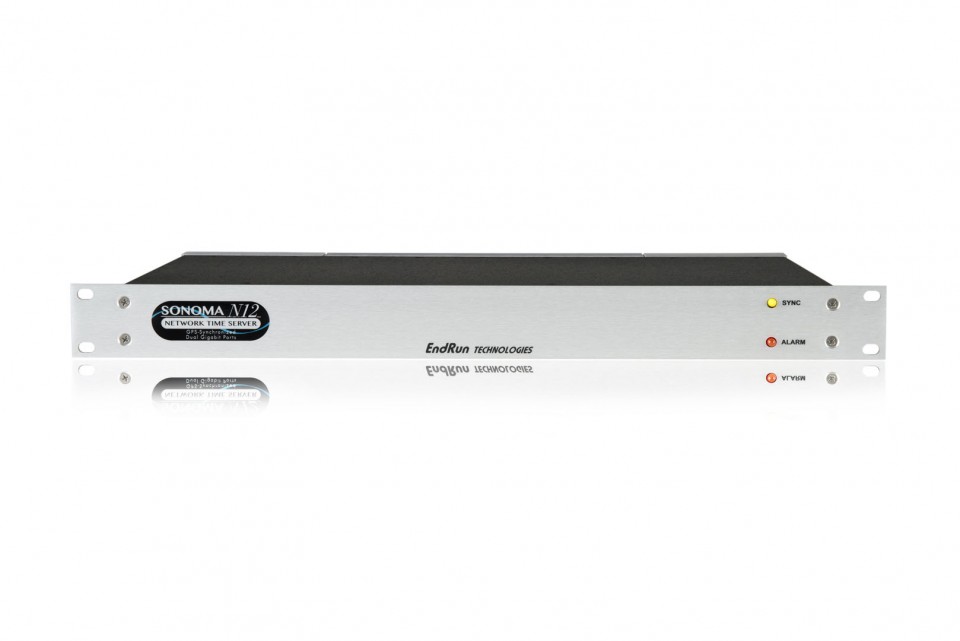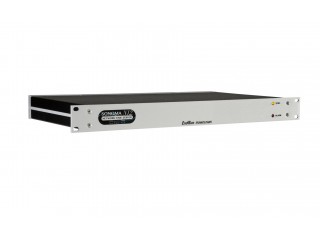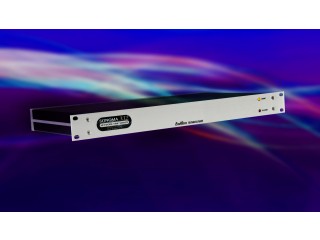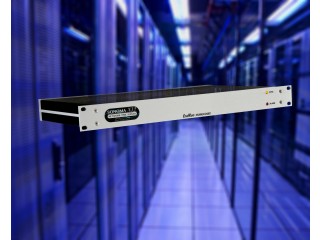EndRun Sonoma N12 Network Time Server (CDMA)
CDMA-Synchronized, Dual Gigabit Ports
[Sonoma-N12-CDMA]Details
Sonoma N12(CDMA)
While installing an antenna on the roof is a typical requirement for most other time servers, with the CDMA-Synchronised Sonoma you can easily mount the antenna inside your building.The Sonoma can serve accurate time to any system running on NTP or SNTP client. With dual gigabit ports and a fast microprocessor for high-capacity packet throughput (7,500 requests/second), it can support hundreds of thousands of network clients with an NTP timestamp accuracy of <10 microseconds. The highly-integrated solid-state design is very reliable, and you can easily manage it via on of the network ports or the RS-232 serial port. A Web Interface (HTTPS) is also provided for status monitoring using your Internet browser.
Network Security Hardened
Extra care has been taken to "harden" the Sonoma against network attacks. There are only a handful of settings that you need to make and they are typically set only once in the lifetime of the product. Since this is a set-it-and-forget-it box, we have eliminated all extraneous protocols/services in order to minimise exposure to security holes. You can change critical settings via SSH or Telnet and monitor the alarm/status information by using HTTPS, SNMP, SSH or Telnet. Security-conscious users can disable any or all of the risky protocols such as HTTPS, Telnet, Time and Daytime and restrict HTTPS, SNMP, SHH, Telnet access to specific hosts.
Time Synchronisation to UTC via CDMA Cellular/PCS Signals
The Sonoma includes a propietary CDMA receiver for synchronisation to Coordinated Universal Time (UTC). It receives its timing information from the Global Positioning System (GPS) via the CDMA mobile telecommunications network used by many cellular/PCS telephones. This means the antenna can be conveniently located inside buildings, anywhere a cell phone signal is available.
PTP/IEEE-1588 Grandmaster Clock Option
The Sonoma can be configured an an IEEE-1588-2008 compliant, Precision Time Protocol (PTP) Grandmaster Clock with high capacity and hardware timestamping. The PTP/IEEE-1588 option can be added to one or both of the gigabit ports and delivers the level of performance that is required in high-speed, low-latency systems.
Measurement Statistics and Charting
Real-time charting of NTP, Oscillator and CPU statistics is available via the Web Interface. Measurements are continuously computed and displayed in real-time with daily and weekly charts. The oscillator statistics are good for verification that the unit was locked at a certain time. NTP statistics show the NTP packet rate and the accuracy of the NTP and System Time relative to UTC. The CPU statistics show the free memory, processor load and operating temperature.
High Reliability and Free Technical Support for Life
The Sonoma uses EndRun's power efficient, fanless design that achieves an estimated MTBF of over 25 years (16 years with Rubidium). The system is made in America, backed by a 3-year warranty, and provided with free technical support via phone or email for life. No support contacts required.
| Manufacturer | EndRun |
|---|---|
| Part No. | Sonoma-N12-CDMA |
| End of Life? | No |
| Width | 17" |
| Height | 1.75" |
| Depth | 10.75" |
| Weight [Kg] | 2.72 |
| Time to Lock | < 5 minutes, typical (TCXO) < 10 minutes, typical (OCXO/Rb) |
| Synchronisation Accuracy | CDMA Receiver Accuracy - < 10 microseconds to UTC (USNO) when locked, typical. NTP Receiver Accuracy - < 10 microseconds @ 7,500 requests/second NTP Client Synchronisation Accuracy - Network factors can often limit LAN synchronisation accuracy to 1/2 - 2 milliseconds, typical. |
| Holdover Accuracy | TCXO (standard) - 10 millisecs/day. Serves Stratum 1 time for 24 hours after signal loss. Premium OCXO - 80 microsecs/day. Serves Stratum 1 time for 35 days after signal loss. Rubidium - 5 microsecs.day. Serves Stratum 1 time for 140 days after signal loss. |
| Time/Frequency Output | CE, FCC, RoHS, WEEE |
| Timing Protocols | NTP, NTP v2, v3, v4, SHA/MD5 authentication, and broadcast/multicast mode and autokey SSH client/server with “secure copy” utility, SCP SNMP v1, v2c, v3 with Enterprise MIB HTTPS (Web Interface) TIME and DAYTIME server TELNET client/server FTP and DHCP clients SYSLOG IPv4/IPv6 Optional PTP/IEEE-1588-2008 (v2) |
| Network Ports | Two rear-panel RJ-45 jacks Two 10/100/1000 Base-T Ethernet |
| Front Panel | Sync LED: Amber LED pulses to indicate lock status Alarm LED: Red LED indicates a serious fault condition RS-232 serial I/O on rear panel DB9M jack for secure, local terminal access Parameters fixed at 19200 baud, 8 data bits, no parity, 1 stop bit |
| Receivers | CDMA Receiver: Digital Cellular Mobile Receive Band - 869 - 894 MHz PCS Mobile Receive Band - 1930-1990 MHz Japanese Cellular Mobile Receive Band - 860-875 MHz (optional configuration) TIA/EIA IS-95 CDMA Pilot and Sync Channels TNC connector (female) on rear panel, Z = 50 ohms |
| Oscillator | TCXO, OCXO or Rubidium |
| Power | 10 Watts with TCXO (standard configuration). 11-13 watts with OCXO. 16-23 watts with Rb. 90-264 VAC, 47-63 Hz, 1.0A maximum 3-Pin IEC 320 on rear panel, 2-meter cord included |
| Environmental Temperature | Operating: 0˚ to +50˚C Storage: -40˚ to +85˚C |
| Environmental Humidity | Operating: 5% to 90% RH, non-condensing Storage: 5% to 95% RH, non-condensing |




